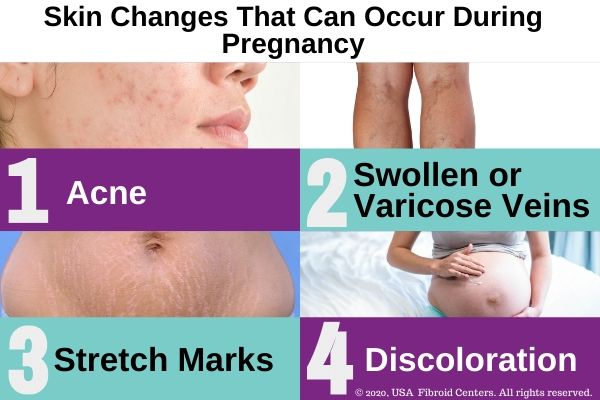
Pregnancy can cause a lot of changes to occur in your body, mind, and life. It’s a huge step in and it definitely requires a lot of preparation. If you’re pregnant, or thinking about becoming pregnant, you may have wondered what symptoms you will develop. Many women don’t realize that along with mood swings and morning sickness comes an increased risk for developing other health conditions, like uterine fibroids.
During pregnancy, your skin will start to change as it stretches to the shape of your growing belly. As you move further along in your pregnancy, you may start to notice some significant differences in the appearance and texture of your skin. Read more to find out all you need to know about how your skin can change during pregnancy, why skin changes, and how hormones may play a key role.
We also recommend following the appropriate pregnancy skincare tips below.
Common Skin Conditions During Pregnancy
Pigmentation Changes
Have you noticed that certain areas of your skin look darker than usual? Hyperpigmentation (skin darkening) is a common occurrence during pregnancy. This is due to increased melanin (skin pigment). You may observe new blotches of darker skin on any area of your body and/or experience additional darkening of the nipples, freckles, scars, or genitals.
Many women develop linea nigra, a dark line that runs from the belly button down to the pubic bone. For some, a “mask of pregnancy” –– also known as chloasma or melasma –– can occur on the cheeks, nose, upper lip, or forehead. These types of skin changes usually fade back to normal within a few months of delivery.
If pregnancy-related pigmentation changes are bothering you, we recommend that you:
- Avoid excessive sun exposure
- Use sunscreen when outdoors
- Don’t wax facial hair
- Cleanse with hypoallergenic products
- Experiment with concealers as desired
Acne
Although you may think that acne only affects teenagers, it can be just as problematic for pregnant women. Acne can occur during pregnancy as increased hormones cause an increase in sebum –– an oily substance that clogs pores and leads to breakouts.Women who previously struggled with acne during their periods are more likely to develop it during pregnancy. Problems with acne are usually most noticeable within the first two trimesters.
Be sure to ask your doctor about the safety of using acne medications during pregnancy, since some are known to cause birth defects. Fortunately, there are a variety of other methods you can try to reduce ugly blemishes.
To improve acne-prone skin:
- Keep your face clean and dry
- Avoid touching your face
- Wash hair regularly or tie back away your face
- Launder pillowcases and towels regularly
- Don’t pick at or pop pimples
- Keep hydrated
- Eat a healthy, well-balanced diet
- Avoid caffeine, sugar, and processed foods
Stretch Marks
You may already be familiar with the possibility of getting stretch marks during pregnancy –– after all, nine out of ten pregnant women develop them. They usually show up during the sixth or seventh month, and can occur on your abdomen as well as surrounding regions like the breasts, hips, upper thighs, and lower back. After delivery, your stretch marks will probably fade –– but not disappear entirely.
Some women wear theirs proudly, while others pay thousands of dollars for expensive treatments with the hope of improving their appearance.
To reduce stretch marks on your own:
- Moisturize skin daily, throughout your entire pregnancy
- Keep weight gain within recommended limits
- After delivery, ask your doctor about the use of retinoids
- Postpartum laser treatments may be an option, but they are costly
Veins
Along with other skin changes, you may have noticed the unwelcome appearance or worsening of varicose and spider veins. Varicose veins are swollen, twisted veins that appear blue or purple beneath the skin. They are hereditary, common during pregnancy, and can occur as the result of an expanding uterus compressing surrounding veins. Spider veins, aptly named for their appearance, tend to occur during pregnancy because of hormonal changes and increased blood flow.
While unattractive, varicose and spider veins are usually considered harmless. Nonetheless, you should bring them to the attention of your doctor. The appearance of these veins often improves postpartum, but if they don’t, both surgical and nonsurgical treatments are available.
In the meantime:
- Wear maternity compression stockings
- Exercise daily
- Avoid standing for long periods
- Change positions throughout the day
- Sleep on your left side to avoid placing pressure on your inferior vena cava

Dry, Itchy Skin
Dry, itchy skin in pregnancy is common, especially in winter. There are various explanations for this, including hormones and stretching skin. In rare cases, itchy skin –– without a rash –– may be a sign of a liver condition called Intrahepatic Cholestasis Of Pregnancy (ICP). Itching due to ICP is usually worse at night and most focused on the hands and feet. However, it can occur any time of day and anywhere on the body.
Although ICP goes away after delivery, the condition requires immediate medical attention. Always discuss itchy skin in pregnancy with your doctor.
You may find the following tips helpful:
- Wear loose, comfortable, breathable clothing
- Use unscented lotion or moisturizer
- Take a warm bath
- Apply ice to affected areas
Pruritic Urticarial Papules and Plaques of Pregnancy (PUPPP)
PUPPP involves the development of itchy bumps. These usually develop along pregnancy stretch marks and can spread to other areas. PUPPP usually occurs in the third trimester, during first-time pregnancies. Although potentially uncomfortable and unattractive, PUPPP is not considered harmful or dangerous for you or your growing baby. It is unknown what causes it, but the condition typically resolves after pregnancy.
To relieve any associated itching, you can follow the same recommendations listed above under Dry, Itchy Skin.
Skin Tags
Skin tags are small, soft, benign growths that often develop during the second trimester. Common sites include the neck, breasts, armpits, or vagina. Even without a prior history of skin tags, pregnancy can lead to their development. Although the causes behind their formation are not entirely understood, some believe it may be related to friction caused by weight gain. Others suggest that hormones play a role.
You should know:
- In most cases, the presence of skin tags is not much of a problem
- They often resolve on their own after delivery
- You should avoid using topical skin tag removers during pregnancy
- If your skin tags are bothersome, you can have them removed after giving birth
Uterine Fibroids and Pregnancy
Skin changes aren’t the only potential health issues pregnancy can influence. You may find that you’re more prone to injury as your abdomen grows and your balance changes. Or, you may notice that your sense of taste or smell changes as the weeks progress. Some individuals may even discover new issues involving their reproductive tract –– such as the development or worsening of uterine fibroid symptoms.
Uterine fibroids are noncancerous tumors that commonly develop in or on the uterus. Along with changing skin, some women experience fibroid growth and increased fibroid symptoms during pregnancy. This is because fibroids, like many of the above skin conditions, are related to higher levels of hormones.
Common symptoms of fibroids include:
- Heavy and prolonged menstruation between or during your periods
- Anemia, which can lead to fatigue
- Pain during intercourse
- Frequent urination
- Constipation and/or bloating
- Pain in your pelvis or lower back
- Increased menstrual cramping
- Stomach swelling
If you are thinking of becoming pregnant and have uterine fibroids, it’s very important that you pursue treatment as soon as possible. This will help prevent your fibroids from making you go infertile, as well as prevent complications from occurring during or after the treatment. If you are currently pregnant, you cannot undergo treatment for uterine fibroids of any kind until the baby is delivered.
At USA Fibroid Centers, our experts specialize in Uterine Fibroid Embolization (UFE) –– a minimally invasive procedure for uterine fibroids that can reduce symptoms and quickly get you back to living life at its fullest. Contact us today for more information.
Are you interested in learning more about uterine fibroids? Sign up for our newsletter and check out some of our other blog articles:
Uterine Fibroid Embolization Treatment Guide



